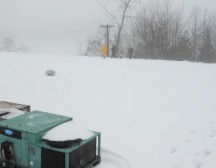Is one’s business or facility ready for the winter ahead? Hopefully, by now, every section of a roof has had a thorough inspection fall inspection. If not, there’s still some time to ensure clogged drains, scuppers, and other issues are cleared and in good shape for the coming season.
The neglection of these issues and failure to winterize the roof of a building before the snow starts coming down in blankets is an absolute recipe for disaster–even more so if a roof is nearing the end of its serviceable life. A well-maintained roof is not as prone to leaks or structural damage from snow loads. Lest one forgets about the daily freeze and thaw cycles that occur during winter.
Risk Increase
Roof failure comes from neglecting to find and repair existing deficiencies. While defects in flashing and sealant failure at penetrations are leading causes of leaks, splits in the membrane, separations at seams, ridges, blisters, and deterioration are also red flags that must be addressed before winter. A little professional attention now will save a lot of money and headache down the road.
Roof Coating
A single-ply membrane that is nearing the end of its life can become brittle and prone to leaks. When at this stage, they become less sound all the way around. One should never take the gamble and head into winter with an old, faded, and patched membrane. Applying a roof coating now could extend your roof’s life and help protect it from winter’s wrath. Coating can also be helpful for aging metal roofs.
Be aware that not all roofs qualify for coating. If one’s does, it can be a cost-effective method of protection. A roofing professional like those of Shoreline Roofing & Exteriors will inspect the roof, replace any wet insulation that might be present, and repair damaged flashing and other problems before applying a coating.
The coating process is not a job for a maintenance crew. Using an incompatible coating or not applying properly could result in the creation of more problems. Shoreline Roofing is a company with experience in applying high-quality coatings and knows that it is essential for the longevity of a roof’s integrity.
Have a Snow Plan
Excessive snow on the roof is a hazard, and in extreme cases, it can lead to roof collapse. Protect the roof with a proactive commercial roof snow removal plan. A fresh, lofty snow can add 20 lbs. of weight per cubic foot, but wet snow, or partially thawed and refrozen snow, can add as much as 60 lbs. per cubic foot of weight. If one lives in a northern clime, your roof was probably designed to bear some additional snow load, but the best practice is to have heavy snows promptly removed. To prevent damage to the roof and reduce the risk of injury to a worker, snow removal is best left to the pros.
In case of a collapse, bear in mind that Shoreline Roofing & Exteriors has a twenty-four-hour emergency service.

